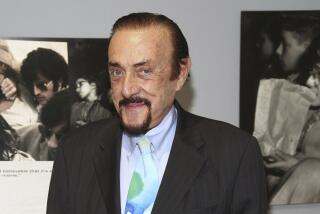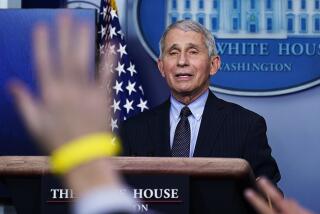Scientists Grow Frustrated Over Fusion Claim
- Share via
Scientists at major research institutions throughout the country are growing increasingly frustrated over their inability to replicate a supposedly simple experiment that purportedly achieves nuclear fusion at room temperature.
Although there have been scattered confirmations of parts of the experiment announced a month ago at the University of Utah, no U.S. laboratory has been able to verify the entire experiment. Not even one of the major research laboratories best equipped to repeat the experiment has succeeded. That includes national laboratories at Los Alamos, Brookhaven and Livermore that are in the forefront of energy research.
Doubts Remain
That track record is why many of the nation’s top scientists remain doubtful that B. Stanley Pons of the University of Utah and Martin Fleischmann of the University of Southampton, England, really did achieve fusion in a flask, as they claimed on March 23.
At this point, no matter which way it turns out, this scientific mystery will go down as one of the most unusual chapters in the history of science.
Either Pons and Fleischmann, both of whom have solid reputations in the field of electrochemistry, have committed a blunder of extraordinary proportions, or the best and the brightest minds in energy research have been befuddled by an experiment that looks so simple it would not be a serious challenge for a freshman chemistry student.
Recently, a team at Stanford University announced that it has detected excess heat that cannot be caused by a chemical reaction, and therefore is most likely nuclear in nature, and another team at the University of Florida has detected significant amounts of tritium, a hydrogen isotope that is produced in fusion reactions.
But those claims of success only add to the frustration of other scientists who have been skunked in the race to repeat the experiment.
Nowhere is that more apparent than at Caltech, where a multifaceted team of experts has labored in vain to come up with something that would either prove or disprove the Utah claim. Last Friday afternoon, a seminar on “cold fusion” had to be moved from a classroom to the campus’ largest auditorium to accommodate a crowd of several hundred.
Many of those who showed up rushed to the front rows of the auditorium, expecting to see a demonstration of the fusion experiment, but electrochemist Nathan Lewis shattered that dream in an instant.
“Our results,” he said as he faced the packed auditorium rather sheepishly, “are zero.”
To Continue Efforts
Scientists there will continue their efforts, however.
Details of the work at Caltech, which were disclosed at the seminar, are embargoed until the scientists publish reports in professional journals, but the human drama revealed at the session may be of greater interest anyway.
Researchers at Caltech began working on the problem within hours of the Salt Lake City press conference, and “we’ve been working pretty much around the clock ever since,” Lewis told the seminar.
Scores of experiments have been completed as the scientists there tried to guess exactly how the Utah group had set up the experiment. From the beginning, researchers have been hampered by a lack of details, a shortfall that grows more puzzling as time goes on.
“It (the experiment) could easily be defined, but it hasn’t,” Lewis said. “We’re frustrated about that.”
Shows Exasperation
At one point, he asked in exasperation why Pons has not taken one of his experiments to one of the major national laboratories and asked scientists there to test it with their sophisticated equipment. Why not, he asked, when “everybody knows they were first now.”
Pons could not be reached because even though he has used the media to stake his claim, he now declines interviews.
While Pons has not taken one of his experiments to a major lab, his partner has. Fleischmann is a consultant to England’s Harwell Laboratory, operated by that country’s Atomic Energy Authority, and he has taken some of his own experiments there for further testing. However, Harwell officials have declined all comment until their research is completed, which could take at least another month.
These days, as scientists who have grown weary from long nights in the laboratory try to explain their inability to replicate the experiment, touches of bitterness often surface. During the Caltech seminar, speakers were frequently interrupted by applause and cheers when they suggested repeatedly that Pons and Fleischmann were so eager to claim credit for their work that they made their announcement prematurely and that their work was seriously flawed.
Not Answering Questions
Much of the criticism stems from the fact that Utah researchers have still not answered some of the basic questions other scientists have been asking about the experiment.
Not everyone at the Caltech seminar was ready to write off Pons and Fleischmann, however.
“What they are saying,” one colleague muttered to another as they left the auditorium, “is if you guys are so smart, figure it out for yourselves.”
If other claims from reputable institutions are to be believed, some people have done just that.
The most difficult research for the doubters to dismiss at this point comes from Stanford University. A seven-member team, led by materials science professor Robert A. Huggins, announced last Tuesday that a series of carefully controlled experiments there had confirmed that the Utah experiment does produce excess energy in the form of heat.
Use ‘Heavy Water’
Furthermore, only experiments that used “heavy water” that has the isotopes necessary for fusion produced the heat. Control experiments that used ordinary water produced no energy, thus ruling out the chance that the heat was caused by some form of chemical reaction.
When Lewis was asked about the Stanford results in the Caltech seminar, he shrugged and said “he (Huggins) is a good guy.”
But he said he did not know enough about the Stanford work to comment further.
The differences between Stanford and Caltech suggest that there is some little secret about the experiment that Stanford researchers have figured out. Otherwise, Stanford will join a list of institutions that have announced success and then had to back off. Both Texas A&M; and the Georgia Institute of Technology have had to bury their pride and admit that earlier claims of success were in error because of problems with equipment.
That backpedaling illustrates one of the other frustrations of the project: While the experiment itself looks easy, detecting the results is extremely difficult.
Devilish Bit of Irony
And in that there is a devilish bit of irony.
The laws of physics, as now understood, suggest that Pons and Fleischmann “would not have been around to hold their press conference” if they had achieved the level of nuclear fusion that they claimed, said Caltech physicist Charles Barnes. The experiment should have become so radioactive that it would have been lethal to anyone within about a mile unless properly shielded.
However, the experiment produces so little radioactivity that it is not even necessary to shield it, and thus is very difficult to measure, according to the Utah scientists.
And that, to physicists, is the biggest mystery of all.
Scientists are still searching for a credible explanation of why the experiment suppresses the radioactivity that should be the “signature” of a fusion reaction.
Pons and others have theorized that the energy produced by the reaction is absorbed in the apparatus and released as heat instead of high energy neutrons or gamma rays, but other scientists find that explanation difficult to accept.
A Curious Event
Another scientist at MIT came up with a theory similar to Pons’, leading to one of the most curious events in the entire drama.
Top scientists at MIT had announced a couple of weeks ago that they were abandoning their effort to replicate the experiment because they had been unable to validate any of the Utah claims. But when a colleague announced that he could explain how the experiment works, MIT did a back-flip and announced that it was going to patent the theory for a process that other MIT scientists had concluded doesn’t even work.
And so it has gone, week after week.
It may be months before all the answers are known, although Pons is now working with a team of about 60 people at Los Alamos National Laboratory, offering some promise of an early resolution. Los Alamos, like just about everybody else, has been unsuccessful in its efforts to replicate the experiment on its own.
But the scientist who is leading that team said the lack of success has not diminished the interest in the Pons-Fleischmann experiment.
When Pons spoke there recently, about 700 people showed up to hear what he had to say. He told them they had been doing the experiments wrong and he will work with them in the days ahead.






